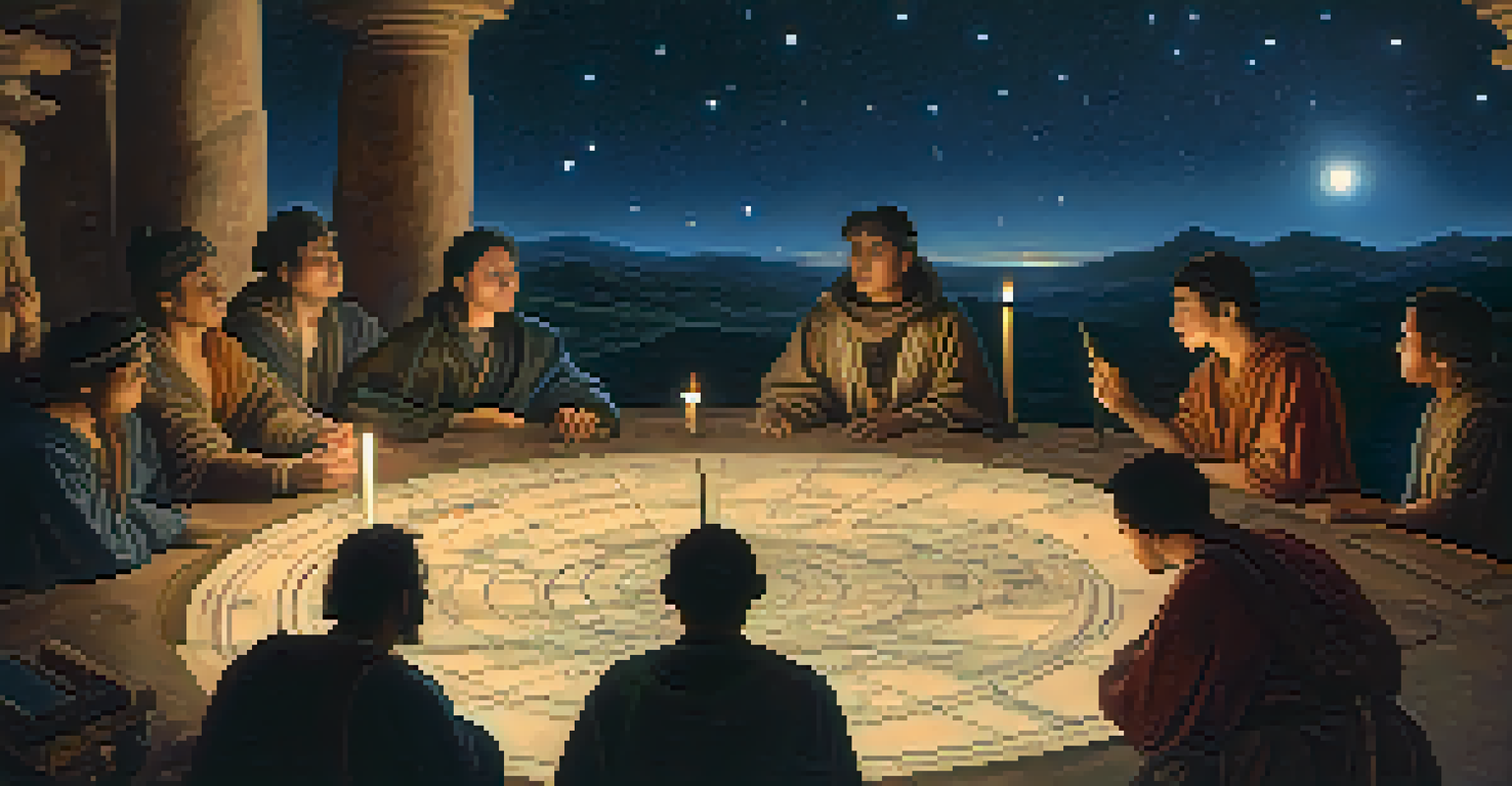Constellations as Spiritual Symbols: A Journey Through Time

Understanding Constellations: More than Just Stars
Constellations are often seen merely as patterns of stars in the night sky, but they hold much deeper significance. Across cultures and ages, these celestial formations have been interpreted as symbols of spirituality, guiding human thoughts and beliefs. Each constellation tells a story, reflecting the values and traditions of the societies that observed them.
The stars are not just points of light; they are the stories of our past and guides for our future.
For instance, the constellation Orion has been associated with various mythologies, from ancient Egypt to Greek mythology. These stories not only illustrate the importance of constellations in navigation but also their role in shaping spiritual narratives. Thus, understanding constellations goes beyond astronomy; it connects us to our cultural heritage and collective spirituality.
As we delve into the spiritual meanings behind constellations, we can uncover how they have influenced human behavior and thought throughout time. This journey reveals a fascinating intersection between the cosmic and the spiritual, inviting us to reflect on our place in the universe.
Ancient Civilizations and Their Celestial Connections
From the Babylonians to the Greeks, ancient civilizations looked to the stars for guidance and inspiration. They created elaborate star maps and attributed divine qualities to various constellations, believing they were messages from the gods. These celestial symbols often played a significant role in agriculture, navigation, and even societal governance.

Take the Greeks, for example; they named constellations after their gods and heroes, weaving these stories into their cultural fabric. Orion, the hunter, and Cassiopeia, the queen, not only served as navigation aids but also as moral lessons and reminders of human virtues and vices. This interplay between the stars and human experience illustrates how deeply intertwined these celestial bodies are with our collective spirituality.
Constellations: Cultural Significance
Constellations hold deep cultural and spiritual meanings, connecting humanity to its heritage and guiding beliefs across civilizations.
Understanding these ancient narratives helps us appreciate how constellations were more than mere points of light; they were integral to the development of human civilization. They provided a sense of order and connection to something greater than ourselves, a theme that resonates throughout history.
The Spiritual Practices Inspired by the Stars
Throughout history, various spiritual practices have been influenced by the observation of constellations. Astrologers, for example, have long looked to the stars for insights into human behavior and destiny. By mapping the positions of constellations, they sought to interpret their meanings and apply them to personal and communal experiences.
To look at the stars is to see the past, but to understand them is to connect with our future.
Many indigenous cultures have rituals tied to celestial events, such as solstices and equinoxes, which are often marked by specific constellations. These practices serve as a reminder of the interconnectedness of life and the cosmos, fostering a sense of belonging and purpose within the universe. The stars become a source of wisdom, guiding individuals in their spiritual journeys.
These spiritual practices highlight the profound impact constellations have on our understanding of life’s mysteries. As we observe the same stars that our ancestors did, we continue to draw inspiration from them, forging a timeless connection to our spiritual heritage.
Modern Interpretations: Constellations in Today’s Spirituality
In today's world, constellations still play a significant role in spiritual beliefs and practices. Many modern spiritual movements incorporate astrology, using the positions of celestial bodies to guide personal growth and self-discovery. This contemporary interpretation reflects a growing desire to reconnect with the cosmos and draw meaning from it.
For some, constellations serve as metaphors for life’s journey, representing the interconnectedness of all beings. They remind us that, just like stars in a constellation, we all have our unique place and purpose. This perspective encourages individuals to explore their spiritual paths with openness and curiosity.
Guidance Through Celestial Symbols
Throughout history, constellations have served as powerful symbols of guidance, helping individuals navigate both physically and spiritually.
As we embrace modern interpretations of constellations, we find new ways to connect with ancient wisdom. This evolving relationship with the stars invites us to reflect on our spiritual beliefs while recognizing the timeless relevance of these celestial symbols.
The Role of Constellations in Mythology and Folklore
Constellations have long been woven into the fabric of mythology and folklore, serving as powerful symbols of human experience. Many cultures created elaborate tales to explain the origins of these celestial patterns, attributing human traits and emotions to them. These stories not only entertained but also imparted moral lessons and cultural values.
For example, the story of Ursa Major, the Great Bear, varies across cultures, with some viewing it as a symbol of strength and guidance. Similarly, the Pleiades have been depicted as a group of sisters, representing unity and togetherness. Such narratives provide insight into how ancient peoples understood their world and the forces that shaped it.
Exploring the role of constellations in mythology allows us to appreciate the rich tapestry of human thought and creativity. These stories continue to inspire modern interpretations, reminding us of our shared humanity in the face of the vast universe.
Constellations as Symbols of Guidance and Direction
Throughout history, constellations have served as symbols of guidance and direction, both literally and metaphorically. Sailors have relied on them for navigation, using the North Star as a fixed point to find their way home. Similarly, many spiritual traditions view constellations as guiding lights in the journey of life, offering wisdom and clarity.
This idea of guidance extends beyond physical navigation; it encompasses emotional and spiritual journeys as well. Just as sailors looked to the stars to find their way, individuals often seek spiritual guidance from the lessons that constellations embody. These celestial symbols remind us that we are not alone; the universe offers support and direction when we need it most.
Evolving Spiritual Connections
As our understanding of the cosmos deepens, the spiritual significance of constellations continues to evolve, blending ancient wisdom with modern insights.
By recognizing constellations as symbols of guidance, we can foster a deeper connection with our own spiritual practices. They encourage us to reflect on our paths and remind us that, even in darkness, there is light to lead us forward.
The Future of Constellations and Spiritual Symbolism
As we look to the future, the role of constellations in spiritual symbolism continues to evolve. With advancements in technology and science, we have a deeper understanding of the cosmos, yet the mystery and wonder of the stars remain. This duality creates opportunities for new interpretations and connections with the celestial realm.
Emerging spiritual movements often blend ancient wisdom with modern insights, offering fresh perspectives on the significance of constellations. As more individuals seek to understand their place in the universe, these symbols may gain even greater importance in personal and collective spirituality.

Ultimately, the future of constellations as spiritual symbols hinges on our willingness to engage with them. By embracing their wisdom and exploring their meanings, we can continue to forge a meaningful relationship with the stars, ensuring that their spiritual significance endures for generations to come.